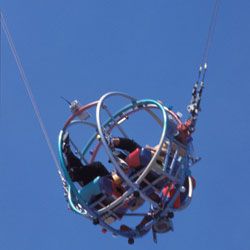You know the feeling. Gliding fast down a smooth highway, your car hits an unexpected dip. For a brief moment, you go airborne before gravity brings the car back to the road, compressing the shocks and giving you a strange sensation in your gut. It's like your stomach is trying to leap out of your body. For some people, it's terrifying. But if you find it exhilarating, you're in luck: From roller coasters to bungee jumping, there are all kinds of ways to experience that sinking feeling you love so much.
But wait -- what exactly causes that sensation, anyway? Though doctors aren't entirely sure, they think it has something to do with the movement of organs and fluids inside your body. See, when you drop on a roller coaster or hit the bottom of a bungee jump, your body is secured by a safety belt or harness, but your organs are free to shift around a little bit. The same is true for the fluids inside those organs. All this movement feels a little funny because you aren't used to it, but it's basically harmless. At worst, it'll make you lose your lunch.
Advertisement

